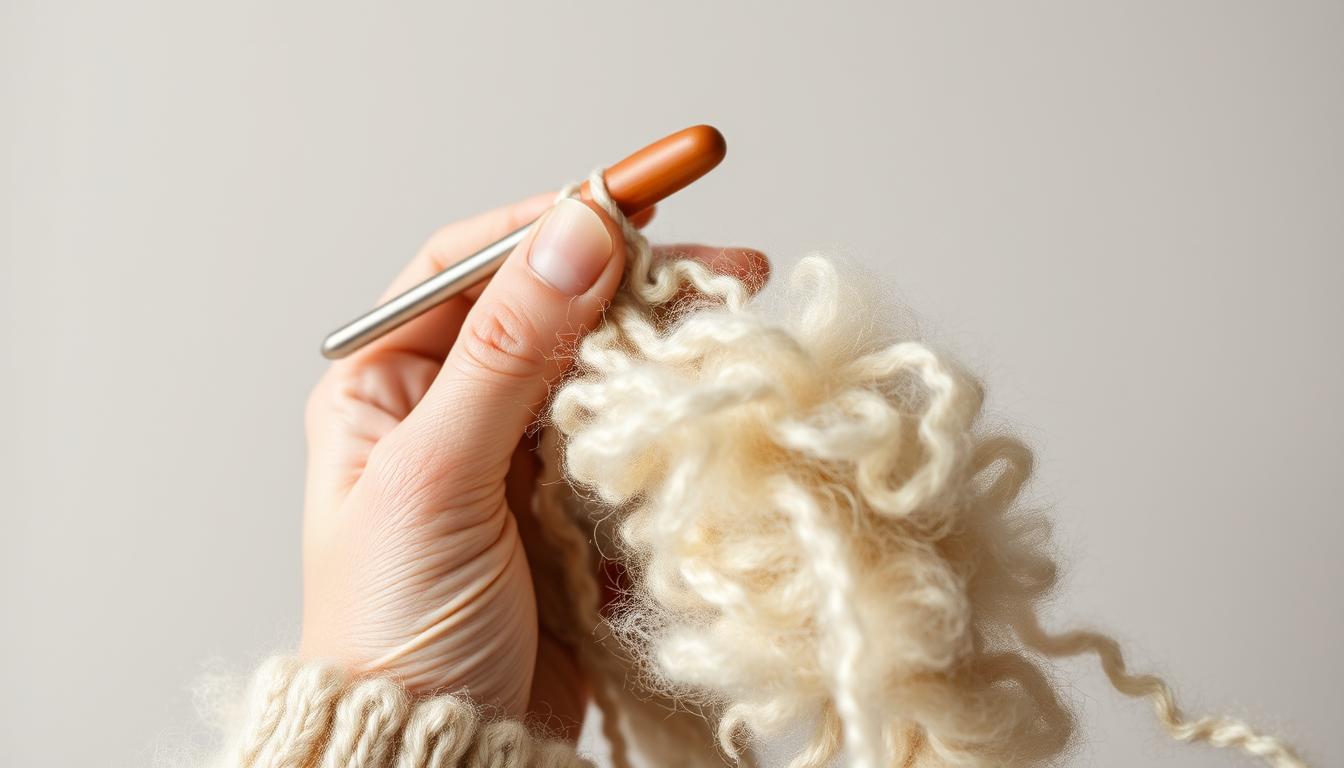
We've all been there – you're happily crocheting along with that gorgeous mohair or fuzzy yarn when suddenly you spot a mistake several rows back. Your heart sinks as you realize you'll need to frog (undo) your work. With regular yarn, this would be simple, but fuzzy yarn with its clingy halo fibers can turn frogging into a nightmare! Don't worry – I've been through this countless times and developed techniques that make frogging fuzzy yarn possible without ruining your beautiful (and often expensive) materials. Let's turn this dreaded task into a manageable one!
Understanding Frogging and Why Fuzzy Yarn Makes It Challenging
Before we dive into the techniques, let's understand what we're dealing with. "Frogging" in crochet simply means to rip out or undo your stitches – the term comes from "rip it, rip it" sounding like a frog's "ribbit, ribbit." With standard yarns, frogging is straightforward, but fuzzy yarns present unique challenges.
What Makes Fuzzy Yarn Different?
Fuzzy yarns like mohair, chenille, bouclé, and faux fur have extra fibers that extend beyond the core strand, creating that beautiful "halo" effect we love. These same fibers, however, tend to cling to each other when crocheted, essentially "felting" together within stitches. When you try to pull these stitches apart, the fibers resist separation and can become tangled or even break.
The most challenging fuzzy yarns include:
- Mohair and mohair blends
- Alpaca with a halo
- Fuzzy bouclé yarns
- Chenille yarns
- Faux fur yarns
Essential Tools for Frogging Fuzzy Yarn
Having the right tools on hand before you start frogging will make the process much smoother. Think of this as preparing for a delicate operation – you want everything within reach before you begin!
Basic Tools
- Blunt tapestry needle - For gently separating fibers without splitting the yarn
- Small, sharp scissors - For emergency situations when yarn becomes hopelessly tangled
- Stitch markers - Bright colored ones to mark important points before frogging
Helpful Additions
- Magnifying lamp - To better see the stitches hidden among the fuzz
- Freezer bag - For the freezer method (more on this later!)
- Crochet hook one size smaller - For picking out individual stitches
Preventative Tools
- Contrasting smooth yarn - For creating lifelines in your work
- Notebook and pen - For tracking pattern rows and stitch counts
- Good lighting - Natural daylight is best for seeing fuzzy stitches
7-Step Process for Frogging Fuzzy Yarn
Now for the main event! Follow these steps carefully to frog your fuzzy yarn project without damaging the yarn or losing your sanity. Remember, patience is key – rushing through this process will only lead to frustration and potentially ruined yarn.
Step 1: Identify and Mark the Mistake
- Carefully examine your work to locate exactly where the mistake is
- Place a brightly colored stitch marker in the stitch just BEFORE where you need to frog to
- Count how many rows you'll need to frog so you know what to expect
- Take a photo of your work for reference if needed
Step 2: Prepare the Area for Frogging
- Work in a well-lit area with minimal distractions
- If possible, lay your project on a contrasting color surface to better see the stitches
- Have all your tools within easy reach
- Take a deep breath – patience is your best friend here!
Step 3: Try the Freezer Method (Optional but Effective)
- Place your project in a plastic bag and put it in the freezer for 30-60 minutes
- The cold temporarily stiffens the fibers, making them less likely to cling together
- Work quickly once you remove it, as the effect only lasts about 10-15 minutes
- This works especially well for mohair and alpaca yarns
Step 4: Begin Slow Unraveling
- Start at the last stitch you worked and begin to undo ONE stitch at a time
- Pull gently with an upward motion rather than yanking sideways
- If resistance is felt, STOP pulling and move to step 5
- For the last few stitches in each row, pull downward instead of upward
Step 5: Use Your Tapestry Needle for Stubborn Spots
- When you encounter resistance, use your blunt tapestry needle to gently separate the fibers
- Insert the needle under the stitch you're trying to undo and lift slightly
- Gently wiggle the needle to loosen the fibers without breaking them
- Once loosened, continue with gentle pulling to undo the stitch
Step 6: Manage the Frogged Yarn
- As you frog, loosely wind the yarn into a ball to prevent tangling
- Don't pull the yarn tight as you wind it – keep it relaxed
- If the yarn becomes kinked or crimped, gently stretch it (don't pull hard!)
- For severely crimped yarn, you can steam it lightly later to restore its texture
Step 7: Assess and Prepare for Reuse
- Once you've frogged back to your stitch marker, check that you're at the correct spot
- Examine the frogged yarn for any damage before reusing
- Let the frogged yarn rest for a few hours before reusing if possible
- If the yarn is severely kinked, lay it out in a figure-8 pattern to relax it
Make Frogging Easier with the Right Tools!
The right tools make all the difference when working with fuzzy yarn. Check out my recommended toolkit with everything you need for stress-free frogging.
View Recommended ToolsPro Tips for Fuzzy Yarn Success
Preventing Future Frogging Nightmares
The best way to deal with frogging fuzzy yarn is to minimize how often you need to do it! Here are some preventative measures that have saved me countless hours of frustration:
- Use lifelines - Thread a contrasting smooth yarn through your stitches every few rows as a "save point"
- Count stitches frequently - Check your count at the end of each row to catch mistakes early
- Use stitch markers liberally - Mark pattern repeats to keep track of where you are
- Work in good lighting - Natural daylight or a good craft lamp makes a huge difference
- Take breaks - Tired eyes miss mistakes that fresh eyes catch immediately
Fixing the "Halo" After Frogging
After frogging, your fuzzy yarn might look a bit sad and flat. Here's how to restore its beautiful halo:
- Gently steam the yarn (don't wet it) by holding it above a steaming kettle
- Use a clean, soft toothbrush to lightly brush the yarn and fluff up the fibers
- Allow the yarn to rest overnight before reusing it
- For severely flattened yarn, try the "figure-8" winding technique around two chair backs
Quick Tip: The "Unknit" Method
For extremely stubborn sections, try the "unknit" method: Instead of pulling to undo stitches, use your hook to essentially work the stitches in reverse, one by one. This takes longer but can save yarn that would otherwise break from pulling.
Troubleshooting Common Frogging Problems
Even with the best techniques, you might encounter some challenges when frogging fuzzy yarn. Here are solutions to three common problems:
Problem #1: Yarn Breaks During Frogging
Solution:
If your yarn breaks, don't panic! Join the broken ends with a small knot, then when you reach that point in your crocheting, work over the knot to hide it. For valuable yarns like pure mohair, consider using the Russian join or spit splice methods for a seamless connection.
Problem #2: Lost Stitch Count
Solution:
If you've frogged back but aren't sure if you have the correct number of stitches, use stitch markers to count in groups of 5 or 10. Can't see the stitches clearly? Try running a contrasting smooth yarn through the "live" stitches, then count the loops of the contrasting yarn.
"Frogging fuzzy yarn is like performing surgery on a fluffy cloud – it requires patience, precision, and the right tools. But with practice, you'll be able to fix mistakes without fear!"
You're Now Ready to Tackle Any Fuzzy Yarn Mistake!
Frogging fuzzy yarn doesn't have to be a nightmare that makes you avoid these beautiful yarns altogether. With the techniques we've covered, you can approach your fuzzy yarn projects with confidence, knowing that if mistakes happen (and they will!), you have the skills to fix them without ruining your precious yarn.
Remember, patience is the most important tool in your kit. Take your time, be gentle with your yarn, and don't be afraid to put a project aside for a bit if frustration sets in. Your beautiful fuzzy project is worth the extra care!
Never Fear Fuzzy Yarn Again!
Want to master more advanced crochet techniques? Join my newsletter community for weekly tips, free patterns, and exclusive tutorials. Plus, get my "Fuzzy Yarn Project Collection" with 5 beginner-friendly patterns perfect for practicing your new frogging skills!
Join the Crochet CommunityHave you had any fuzzy yarn frogging disasters or successes? I'd love to hear about your experiences in the comments below! And if these tips helped you rescue a project, I'd be thrilled to see before and after photos!
FAQs
1. What does “frogging” mean in crochet?
Frogging means ripping out your stitches to fix a mistake. The term comes from "rip-it, rip-it," which sounds like a frog’s croak. In crochet, it means undoing rows or sections to correct errors.
2. Why is frogging fuzzy yarn harder than regular yarn?
Fuzzy yarn, like mohair or eyelash, has lots of loose fibers that stick together. These fibers can tangle or snag, making it tough to pull out stitches smoothly. Regular yarns usually slide apart more easily.
3. How can I avoid damaging my yarn while frogging?
Work slowly and gently. Use tools like a yarn needle or wide-tooth comb to ease apart stuck fibers. Don’t yank on the yarn—pull slowly and check for snags as you go.
4. Are there any tools that make frogging easier?
Yes. Good lighting, sharp scissors, a tapestry needle, yarn comb, and stitch markers all help. A flat clean workspace also makes it easier to spot problems and handle your yarn.
5. What do I do if my yarn gets badly tangled?
Lay your project flat. Use your fingers to gently pull apart knots or use a blunt needle to tease them out. If the tangle is impossible, carefully trim the affected part and rejoin the yarn.
6. Can you fix small mistakes in Filet Crochet without frogging?
Yes. Try duplicate stitching, weaving faux stitches, or adding small patches over the error. Sometimes the fuzziness will hide minor problems, especially if they are not in a focal area.
7. Is it normal to make mistakes in Filet Crochet?
Absolutely. The mesh pattern and chart-following can trip up even experienced crocheters. Mistakes mean you’re learning, and fixing them builds your skills.
8. How do I keep from making the same mistake twice?
Regularly count your stitches, use stitch markers to break up big sections, and check your work under good light. Taking breaks and slowing down helps prevent repeat mistakes.

Christa Patel is a longtime crochet enthusiast, teacher, and founder of Secret Yarnery. With over 30 years of crochet experience, Christa is passionate about making crochet easy and fun for everyone—beginners and experts alike. She specializes in Filet Crochet, textured patterns, and exploring new yarns, including those tricky fuzzy fibers.
Christa shares her knowledge through clear tutorials, helpful guides, and a friendly YouTube community. Her mission is to help crafters build confidence, fix mistakes without stress, and discover joy in every project. When she’s not crocheting, Christa enjoys time with her family, exploring color combinations, and inspiring others to create handmade treasures.
Follow Christa for more tips, project ideas, and crochet encouragement:
Let Christa’s expert advice guide your next crochet adventure!
















